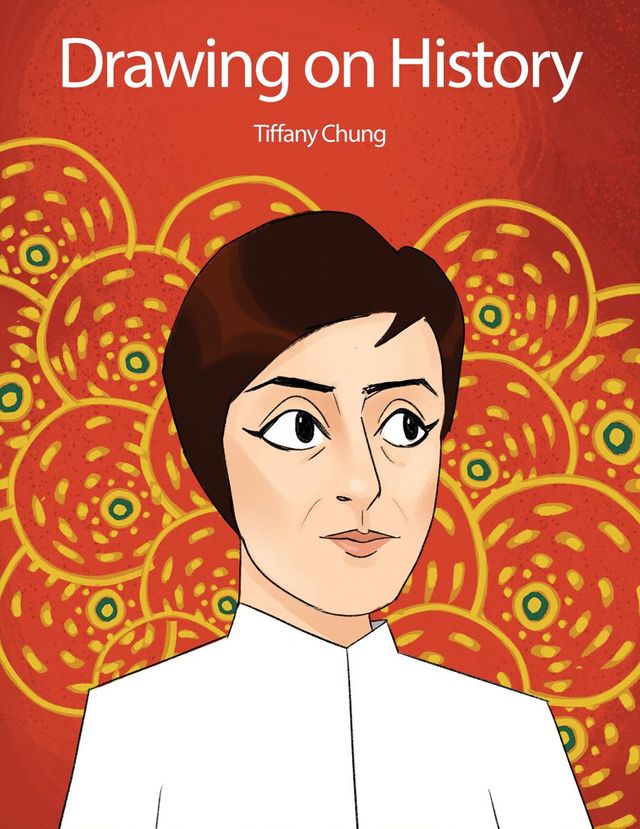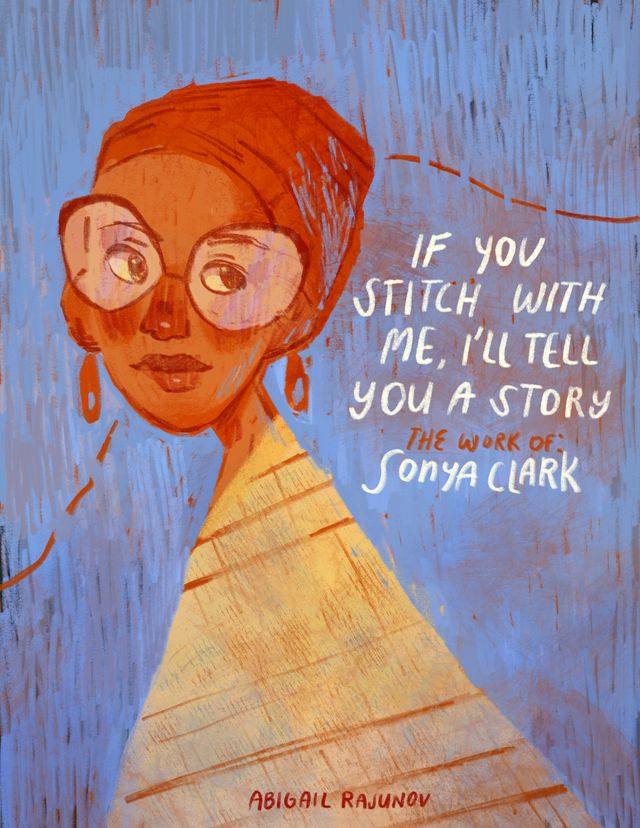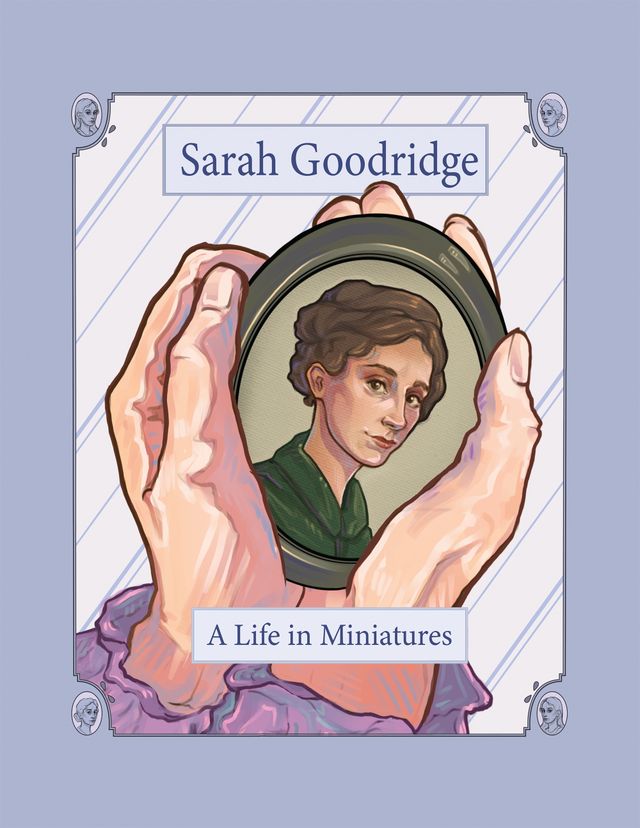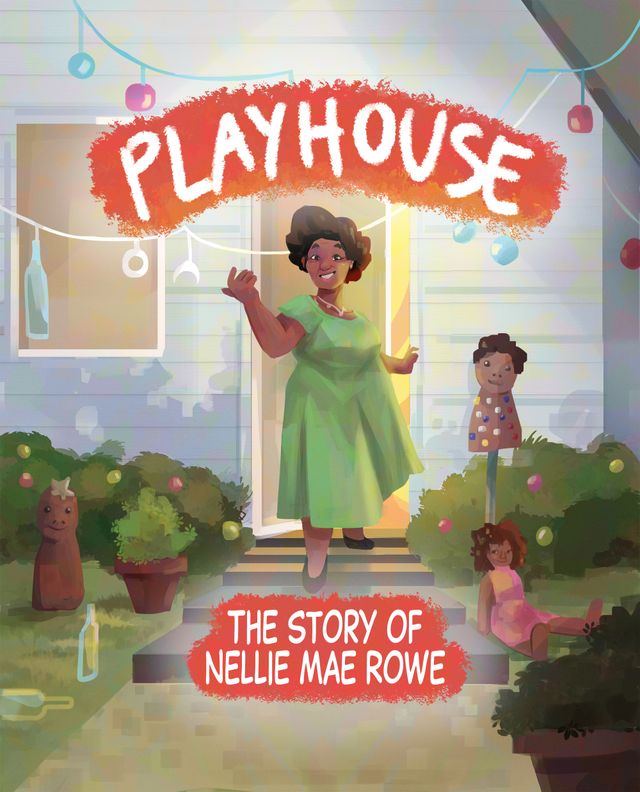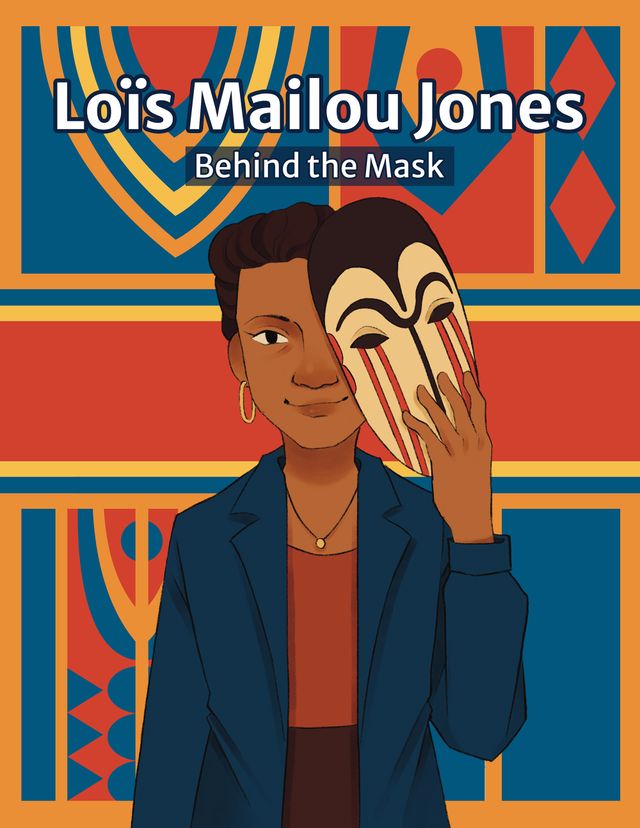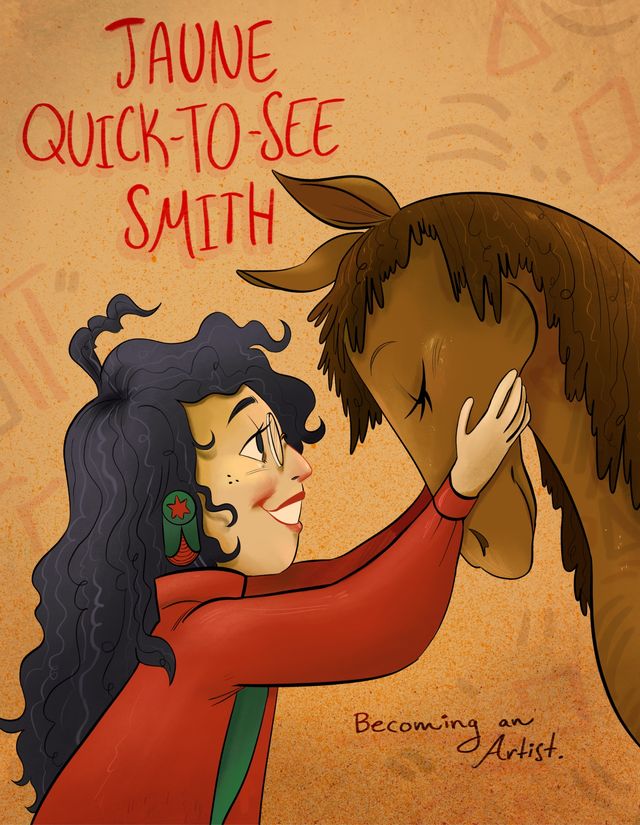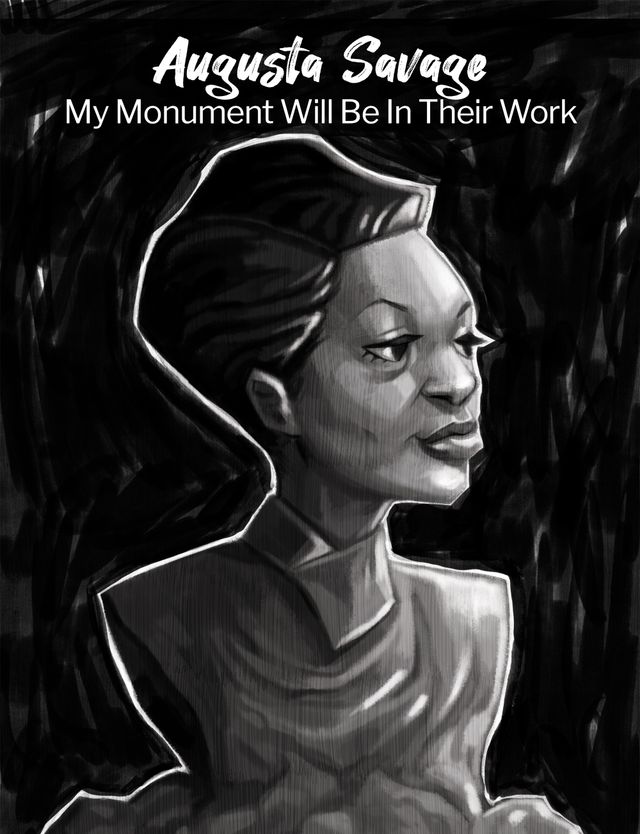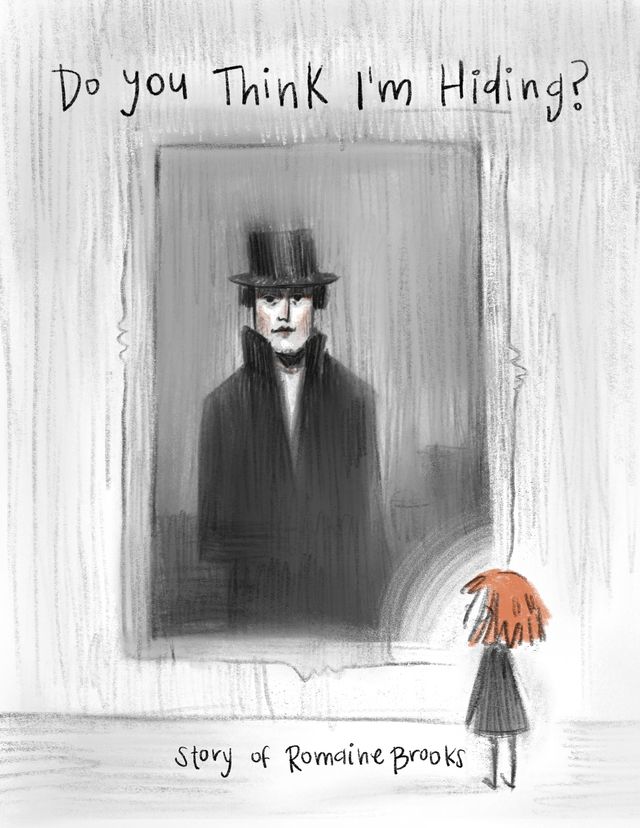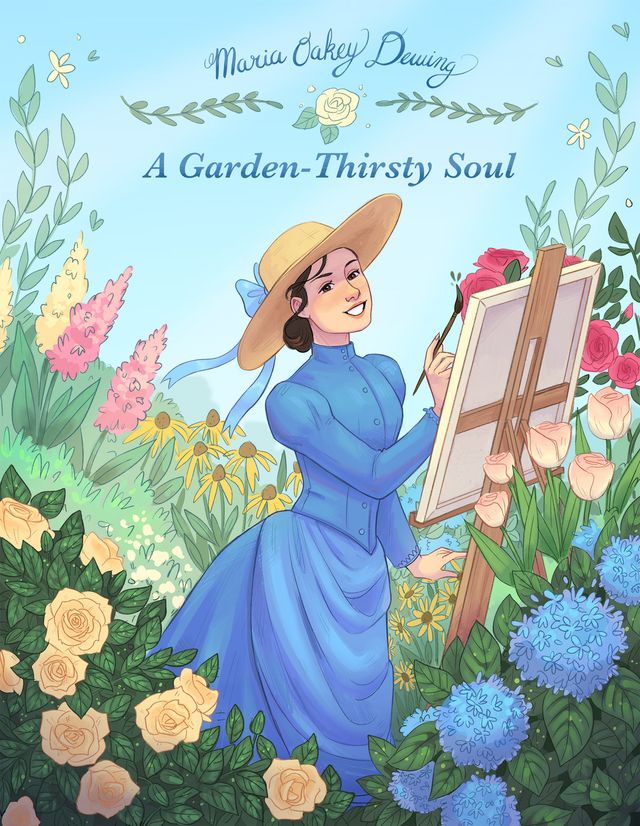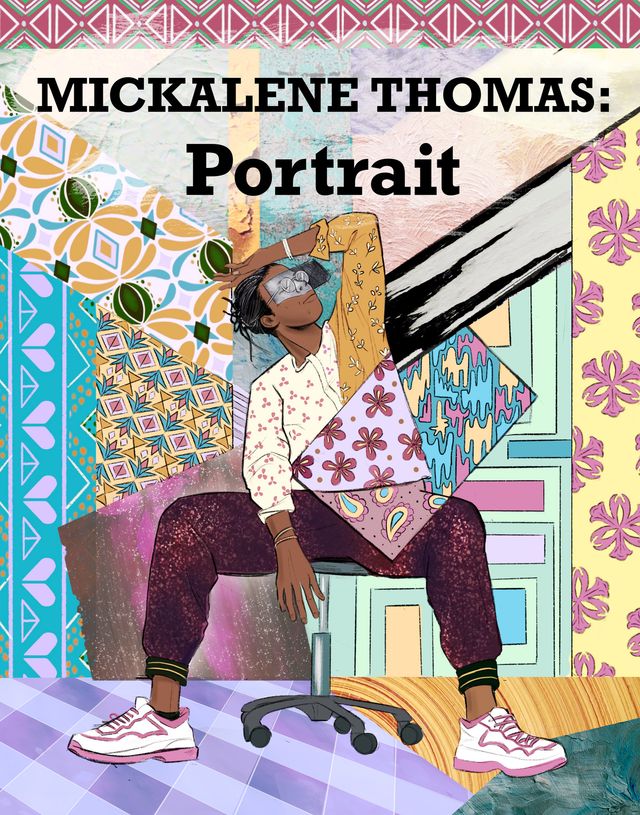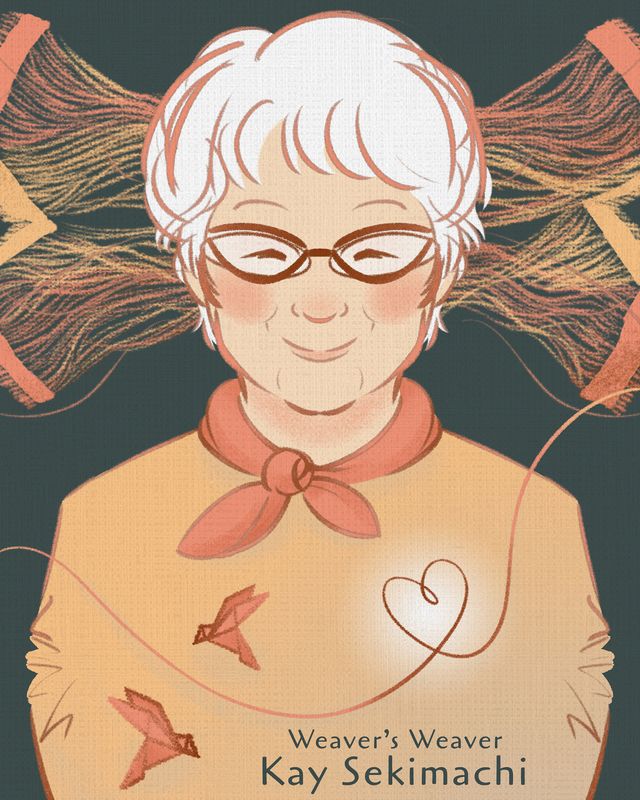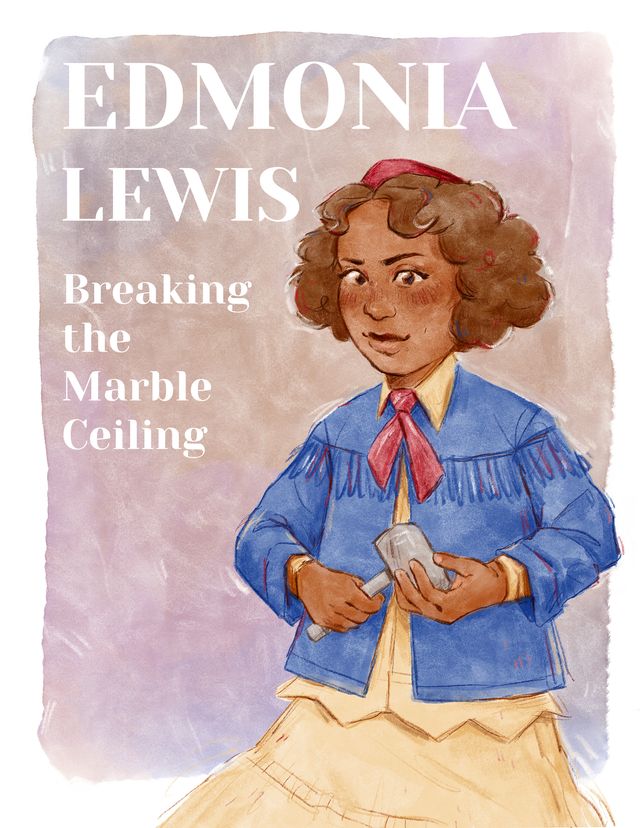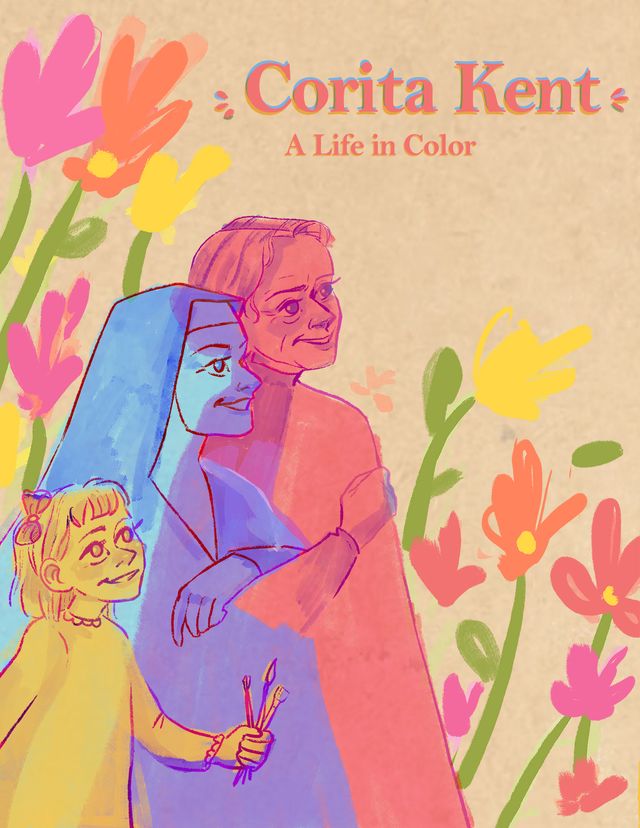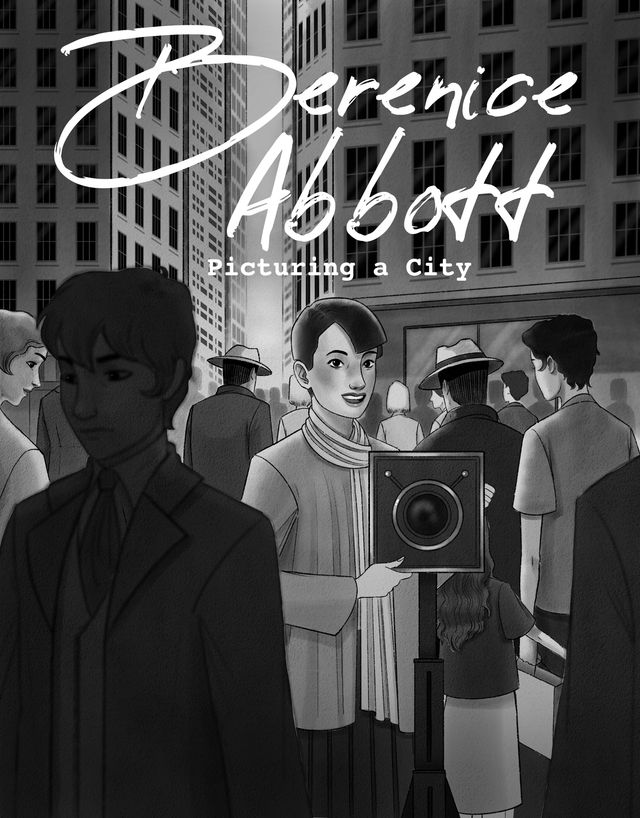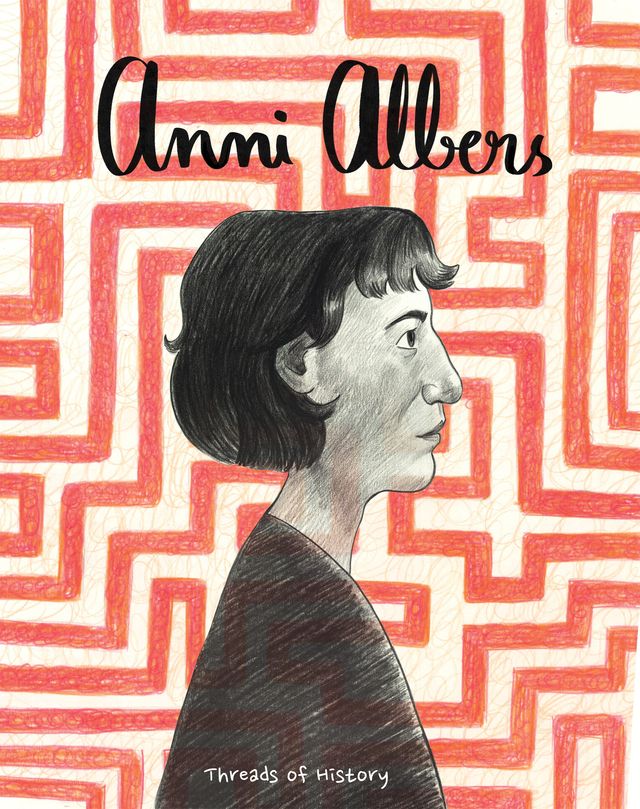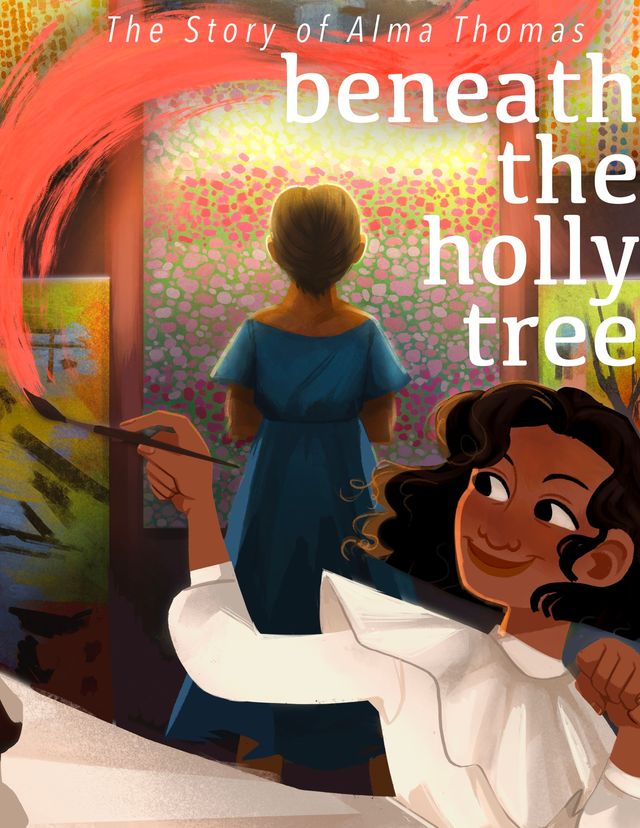An Overview
Emma Amos was a postmodern African-American painter and printmaker. She worked with political and feminist collectives throughout her career, creating colorful multi-media works that talked about her identity as a Black woman.
This comic is part of a series Drawn to Art: Tales of Inspiring Women Artists that illuminates the stories of women artists in the collection of the Smithsonian American Art Museum. Inspired by graphic novels, these short takes on artists’ lives were each drawn by a student-illustrator from the Ringling College of Art and Design.
We invite you to read the comic and share it with your friends and young people in your life.

Cover
A woman with a medium skin-tone looks at the viewer smiling. She has long, wavy gray hair and is wearing a loose dark blue sweater over a black V-neck top. She is wearing a multi-strand necklace with a blue rectangular stone. She holds a paintbrush in her right hand, which is raised over her head. Her left hand is raised slightly at her side, and she holds orange yarn that loops around her fingers and off the page. Behind her is a white, pink, and yellow rectangle with illustrated woven texture and yellow stars scattered on top. Each star has a blue eye at its center. Behind this yellow rectangle is a border of purple, brown, orange, and green stripes, representing the fabric borders seen in Emma Amos’s textiles. Above the woman’s head, brown text reads: "Emma Amos" and then "Winning" in orange font that resembles stitching.

Page 1
This page is broken up into three vignettes, one in the top left of the page, one in the middle of the page, and one at the bottom right of the page. There are four light yellow text boxes with black text. The page is surrounded by a border of dark green, orange, teal, red, and black stripes, meant to represent woven fabric.
Panel 1
A young girl with a medium skin tone and long curly brown hair is holding a blue crayon in her right hand. She rests her head on her left hand. She is wearing a loose pink sweater and is drawing on white pieces of paper that fly out of the panel onto the rest of the page. Text reads: "As a child, Emma was always drawing."
Panel 2
There is a detailed scene of the inside of a drugstore, with three people: one child, one woman, and one man all with medium skin tones. The child is a young Emma Amos, in a big pink sweater holding a blue crayon, drawing on paper. She is seated in a wooden chair, at a wooden desk, surrounded by books and art supplies. To the left of the page, the woman is carrying a red box filled with gray bottles with red caps. She is wearing a short-sleeved collared teal dress and red boots. Behind her a man stands at counter with bottles on it. He is wearing a blue collared shirt and blue jeans. Sun streaks in behind them from a window placed between rows of shelves against a blue wall. Text reads: "Emma was born in Atlanta in 1937 to a middle-class Black family. Her father and grandfather were pharmacists, and the family owned a drugstore." A second text box reads: "Emma was intensely nearsighted and enjoyed making art."
Panel 3
A pair of medium-skin-toned children's hands and arms wearing pink sweater sleeves reach out of the bottom of the page. They are holding a paper doll of a little girl with a medium skin tone and curly dark hair wearing a pink shirt and pink dress. Text reads: "She loved to make paper dolls for her friends and was always looking at the fashion drawings in the New Yorker magazine."
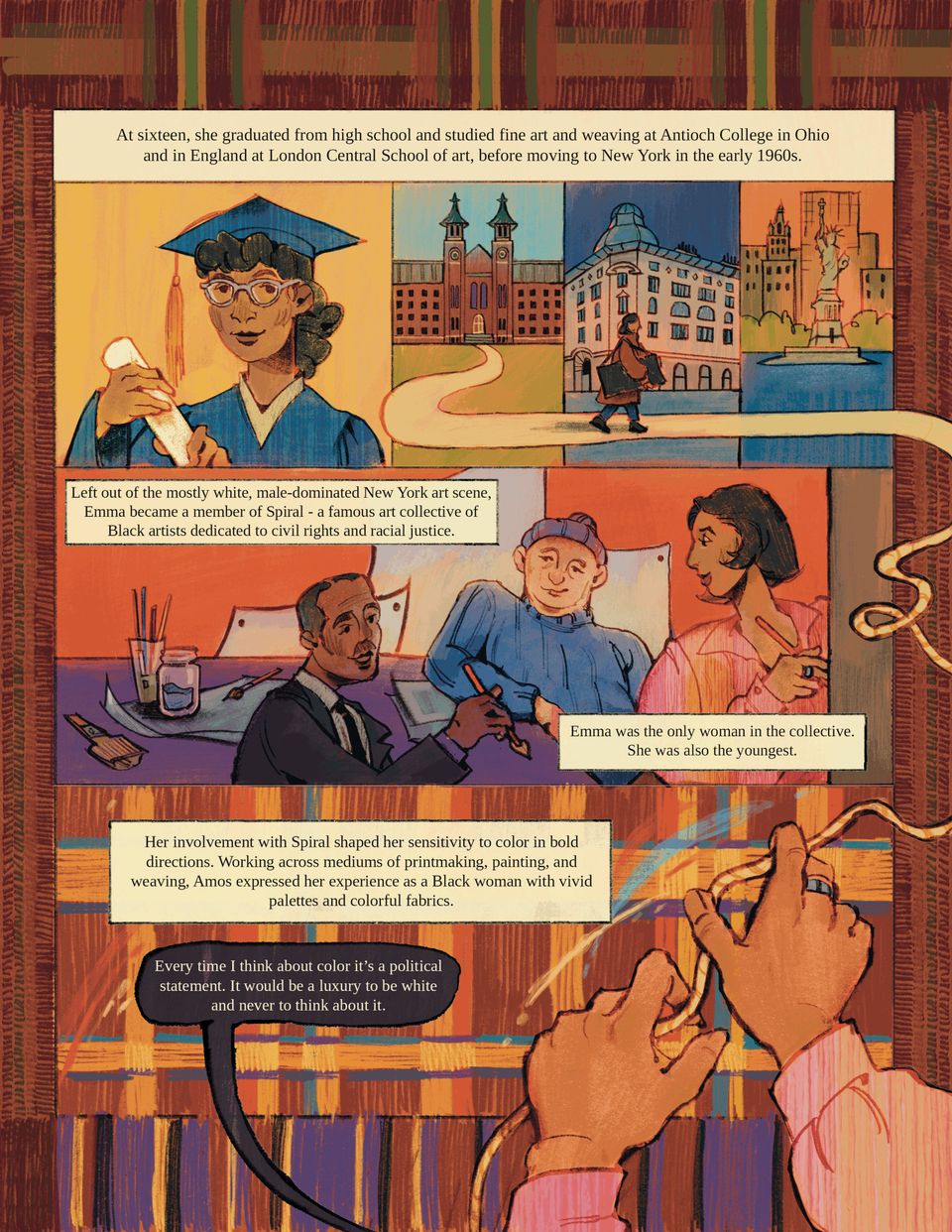
Page 2
This page is broken into four panels, two at the top of the page, one in the middle, and one at the bottom. There are four text boxes that are light yellow with black text, and one speech bubble that is dark purple with white text.
Panel 1
A young woman with a medium skin tone, gray glasses, and curly black hair pulled into a bun is standing against a yellow background. She is wearing a blue graduation cap and gown and holding a rolled-up diploma.
Panel 2
A woman wearing a red coat and blue jeans, carrying a large black bag walks along a yellow path. This path winds between three smaller scenes, forming the streets, and then winds down the page, becoming the yarn that Emma works with. The smaller scenes include one of a big brown building with green spires, one of a gray stone building, and one of the Statue of Liberty with the New York City skyline behind it. Text above Panels 1 and 2 reads: "At sixteen, she graduated from high school and studies fine art and weaving at Antioch College in Ohio and in England at London Central School of Art before moving to New York in the early 1960s."
Panel 3
Three people stand looking at each other in the center of the panel. Behind them are large pieces of white paper floating on a bright orange background. They stand around a large purple table with paintbrushes, paint jars, and paper scattered on top. There is an older man with a dark skin tone, short gray hair, and a mustache wearing a black suit and tie holding an orange paintbrush. Next to him is an older man with a light skin tone who is wearing a gray hat and a blue turtleneck. On the farthest right is a younger woman with short black hair and a medium skin tone, wearing a pink collared shirt holding an orange paint brush. Text reads: "Left out of the mostly white, male-dominated New York art scene, Emma became a member of Spiral - a famous art collective of Black artists dedicated to civil rights and racial justice." Another text box reads: "Emma was the only woman in the collective. She was also the youngest."
Panel 4
A pair of medium-toned woman's hands with large pink sleeves and a silver ring reaches up from the bottom of the page. The hands are weaving with yellow yarn into a checkered background illustrated to look like it's woven. The woven yarn is teal, purple, orange, brown, and yellow. Text reads: "Her involvement with Spiral shaped her sensitivity to color in bold directions. Working across mediums of printmaking, painting, and weaving, Amos expressed her experience as a Black woman with vivid palettes and colorful fabrics." A speech bubble appears from bottom of the page, coming from the figure (Emma Amos) who is weaving. Text reads: "Every time I think about color it's a political statement. It would be a luxury to be white and never to think about it."
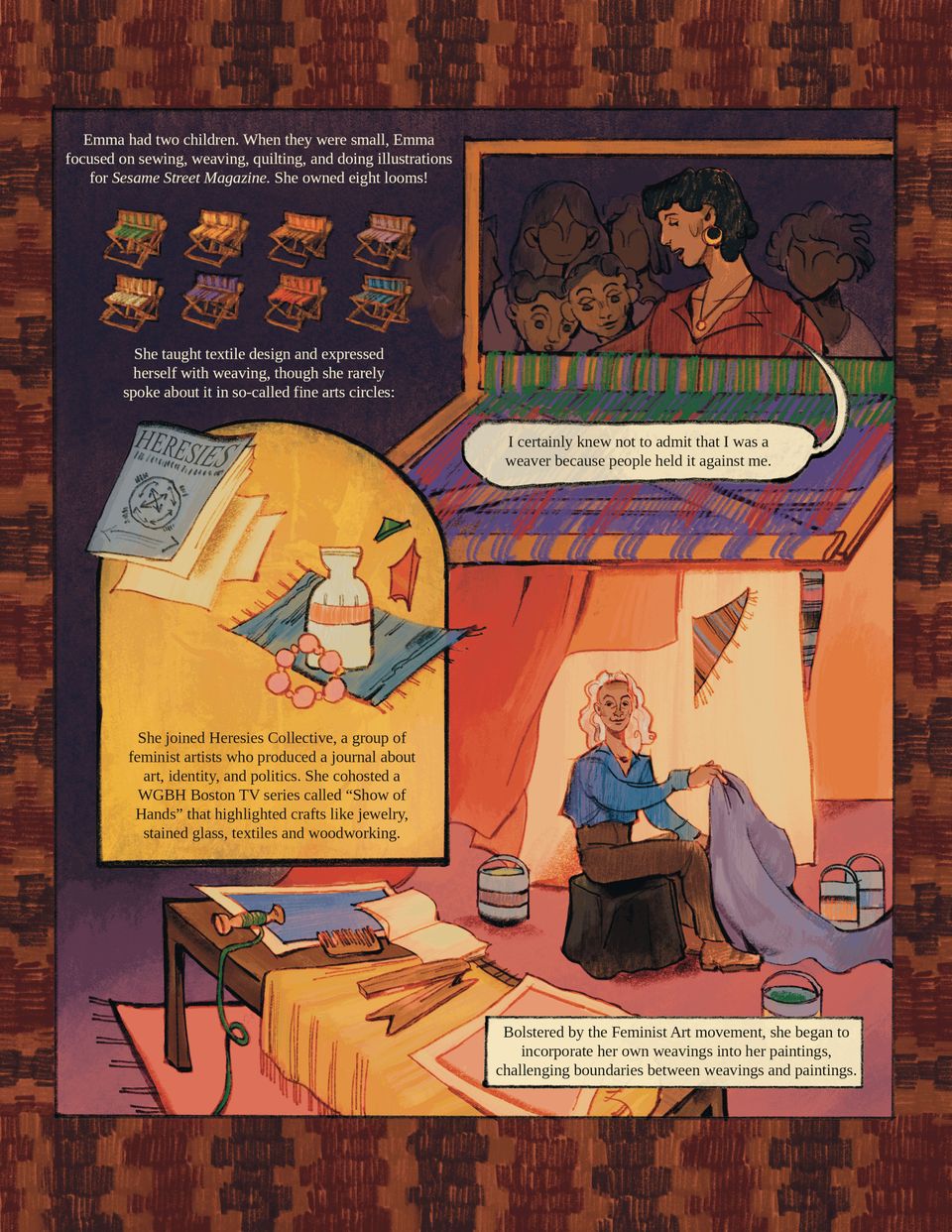
Page 3
This page is broken into four sections, two at the top, one in the middle left, and one larger illustration taking up the rest of the page. There are two text boxes that are purple with white text, one text bubble and one text box that are white with black text, and one text box that is yellow with black text. The border around this page is a checkered woven design of light brown, dark red, and dark brown.
Panel 1
Eight looms float on a purple background, all with different colors of yarn woven into wooden slats. Text in the first box reads: "Emma had two children. When they were small, Emma focused on sewing, weaving, quilting, and doing illustrations for Sesame Street Magazine. She owned eight looms!" Text in the second box reads: "She taught textile design and expressed herself with weaving, though she rarely spoke about it in so-called fine arts circles."
Panel 2
A wooden loom frames an image of a middle-aged Emma Amos speaking to a group of medium and dark skin-toned young women with brown hair. Emma has short black curly hair and is wearing gold jewelry and a red collared shirt. The bottom half of the loom has green, purple, and red yard woven through it. A text bubble coming from Emma reads: "I certainly knew not to admit that I was a weaver because people held it against me."
Panel 3
A gray book titled "Heresies" and a stack of papers sit on a yellow arched background. Next to the book is a blue tablecloth under a ceramic vase, a beaded pink bracelet, and pieces of colored glass. Text reads: "She joined Heresies Collective, a group of feminist artists who produced a journal about art, identity, and politics. She cohosted a WGBH Boston TV series called 'Show of Hands' that highlighted crafts like jewelry, stained glass, textiles and woodworking."
Panel 4
An older Emma sits in the middle of the page on a black cushion. She is wearing a long-sleeved blue top and brown pants. She is holding a large swath of lavender fabric towards the right of the page. Behind her are more large pieces of fabric, in red and orange, and a cream-colored unfinished woven artwork with stripes in the upper corner. Around her are paint cans which sit on a pink floor. In the foreground is a wooden desk sitting on a pink tassel carpet. On the left side of the desk there is a blue piece of paper with a spool of green yarn, wooden weaving equipment, and an open sketchbook sitting on top. On the right side of the table there is a large piece of yellow woven fabric with a piece of pink paper sitting on top of it. Text reads: "Bolstered by the Feminist Art movement, she began to incorporate her own weavings into her paintings, challenging boundaries between weavings and paintings."

Page 4
Background: This page is one large panel. There is white text against a blue background in the upper right, and a black speech bubble with white text in the middle right. The border is brown, red, yellow, and green striped.
An older Emma stands in the center looking at the viewer. She has long curly white hair and is wearing a large blue pendant necklace, a flowy orange long-sleeved top and high-waisted black pants. She is holding a paintbrush in her right hand and has green yarn woven around her fingers. Her left hand is holding the border of the page while her right leg steps over the border toward the viewer. Behind her is a royal blue wall with an illustration of her artwork Winning hung on it. Winning is a multi-media piece showing a black silhouette of a woman leaping off the frame, against a multi-colored woven background. A long strand of green yarn starts on the left side of the page and weaves behind Emma, around her fingers, and up to the right side of the page. Text in the upper left reads: "Her artwork Winning, is a patchwork of woven swatches, threads, and ribbons, that celebrates the life of a Black woman who seems to leap off the frame." A speech bubble coming from Emma reads: "The most important accomplishment of my career is discovering that I had a voice, and that I have had the opportunity to have people hear that voice."

End page
A paper doll of a young girl with a medium skin tone and curly black hair stands in the middle of a yellow background. The doll has white-rimmed glasses, and an orange bow on the side of her hair and is wearing a pink and orange striped dress with white cuffs and a white collar. White ankle socks peak out of black shoes and small white tabs poke out along the edge of the doll. A magenta, brown, and orange-striped pattern borders the page. Orange yarn loops from the bottom left corner up to the top of the page. Black text under the doll reads: "Illustrated by Elena May binti Saini Jeffery."














